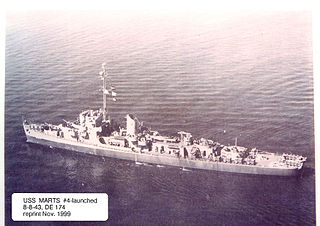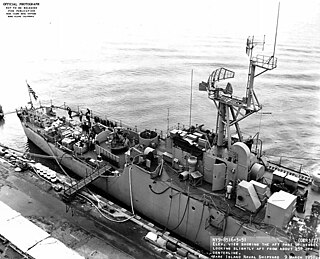
USS Guest (DD-472), a Fletcher-class destroyer, was a ship of the United States Navy named for Commodore John Guest (1822–1879).

USS Acree (DE-167) was a Cannon-class destroyer escort in service the United States Navy from 1943 to 1946. She was scrapped in 1973.

USS Ericsson (DD-440), a Gleaves-class destroyer, was the third ship of the United States Navy to be named after John Ericsson, who is best known for devising and building the Civil War ironclad USS Monitor.

USS Alexander J. Luke (DE/DER-577), a Buckley-class destroyer escort of the United States Navy, was named in honor of Sergeant Alexander J. Luke (1916–1942), who was killed in action during the attack on Tulagi on 6 August 1942. He was posthumously awarded the Silver Star.

USS Major (DE-796) was a Buckley-class destroyer escort in service with the United States Navy from 1944 to 1948. She was scrapped in 1973.

USS LeHardy (DE-20) was an Evarts-class destroyer escort constructed for the United States Navy during World War II. It was promptly sent off into the Pacific Ocean to protect convoys and other ships from Japanese submarines and fighter aircraft. At the end of the war, she had to honor of proceeding to Wake Island, as the Japanese commander surrendered, and raising a flagpole to fly the American flag once again.

USS Marts (DE-174) was a Cannon-class destroyer escort built for the United States Navy. She served in the Atlantic Ocean in 1943-45 before being transferred to the Brazilian Navy. Renamed Bocaina (D-22), she was in service until 1975, when she was struck and scrapped.

USS Pennewill (DE-175) was a Cannon-class destroyer escort built for the United States Navy during World War II. She served in the Atlantic Ocean and provided escort service against submarine and air attack for Navy vessels and convoys.

USS Herzog (DE-178) was a Cannon-class destroyer escort in service with the United States Navy from 1943 to 1944. She was transferred to Brazil on 1 August 1944 and served as Beberibe (D-19) until 1966. She was scrapped in 1968.

USS McAnn (DE-179) was a Cannon-class destroyer escort built for the United States Navy during World War II. She served in the Atlantic Ocean and provided escort service against submarine and air attack for Navy vessels and convoys. As Bauru she is preserved by the Brazilian Navy at Rio de Janeiro.

USS Trumpeter (DE-180) was a Cannon-class destroyer escort in service with the United States Navy from 1943 to 1947. She was sold for scrap in 1974.

USS Straub (DE-181) was a Cannon-class destroyer escort in service with the United States Navy from 1943 to 1947. She was sold for scrap in 1974.

USS Gustafson (DE-182) was a Cannon-class destroyer escort in service with the United States Navy from 1943 to 1946. In 1950, she was transferred to the Royal Netherlands Navy where she served as Hr.Ms. Van Ewijck (F808) until 1967. She was scrapped in 1968.

USS Jacob Jones (DE-130) was an Edsall-class destroyer escort built for the U.S. Navy during World War II. She served in the Atlantic Ocean and provided destroyer escort service against submarine and air attack for Navy vessels and convoys.

USS Herbert C. Jones (DE-137) was an Edsall-class destroyer escort built for the U.S. Navy during World War II. She served in the Atlantic Ocean and provided destroyer escort protection against submarine and air attack for Navy vessels and convoys.

USS Joyce (DE-317) was originally commissioned as a US Coast Guard Edsall-class destroyer escort built for the U.S. Navy during World War II. She served in the Atlantic Ocean and the Pacific Ocean and provided destroyer escort protection against submarine and air attack for Navy vessels and convoys. During its World War II service, on two different engagements with enemy submarines, the Joyce rescued survivors of the tanker SS Pan- Pennsylvania and its sister ship USS Leopold. Joyce received one battle star for its service during World War II.

USS Swenning (DE-394) was an Edsall-class destroyer escort in service with the United States Navy from 1943 to 1946. She was sold for scrapping in 1974.

USS McCoy Reynolds (DE-440) was a John C. Butler-class destroyer escort acquired by the U.S. Navy during World War II. The primary purpose of the destroyer escort was to escort and protect ships in convoy, in addition to other tasks as assigned, such as patrol or radar picket. Post-war, after operating in the Pacific Ocean battle areas, her crew members returned home with four battle stars to their credit for World War II and one for the Korean War.

USS Silverstein (DE-534) was a John C. Butler-class destroyer escort in service with the United States Navy from 1944 to 1947 and from 1951 to 1958. She was sold for scrapping in 1973.

USS Keith (DE-241) was an Edsall-class destroyer escort in service with the United States Navy from 1943 to 1946. She was scrapped in 1974.




















